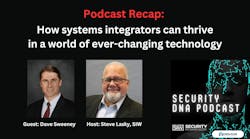No More Silos: How Today’s Integrators Drive Real Security
Key Highlights
- Integration Redefined: Explore the critical role of integration in electronic security, emphasizing its necessity for modern adaptability and responsiveness.
- Real-World Insights: Discover practical applications and success stories that demonstrate how innovative integration frameworks address client challenges.
- Strategic Inflection Point: Understand how the security industry is at a pivotal moment, presenting both challenges and opportunities for those who can pivot and innovate effectively.
This article will break down the meaning of integration in the context of electronic security, the building blocks of modern integration, both inside and outside of our industry, and most importantly, how these principles can be applied to solve the challenges our clients face daily and push our industry forward. It will provide real-world examples of what this looks like in practice, and what a modern framework for integration looks like in the physical security world. If you’re reading this, whether you’re an end-user implementing solutions, a manufacturer designing products, or a service provider putting them together, I hope you leave with a fresh perspective on the immense opportunities that lie ahead for our industry to make our world safer, smarter, and more responsive to the needs of the communities we serve.
How We Got Here
Before I begin, it’s essential to explain how I got here. My journey to the security industry is anything but ordinary and it started in the most unlikely place. In 1993, my dad, Gideon Elfassy, started a company installing CD players and volume controls named Sound Specialists. In 1999, we encountered a quadriplegic client who could only move his left index finger. He gave the team a mission – a way to provide him with independence with technology. With a healthy dose of optimism, a penchant for innovation, and a stroke of luck, they built a robotic arm that extended out of his wheelchair and brought the world’s first commercially available touch panel right to his fingertips.
They wrote a control system software that allowed him to control everything at the touch of a button. Doors, windows, lights, shades, audio, video, and they even built a tracking system using infrared sensors embedded in the walls of his home that would blip his location on a map for his parents and caretakers to find him in his sprawling 30,000 sq/ft home. My dad’s mantra and indeed our tagline has always been “technology simplified.” How we use technology to simplify the spaces around us and help improve people’s lives.
While in college, I worked for Tesla, where I learned about how to use various sensing technologies for real-time detection, and when I graduated, I was recruited to an amazing start-up, MuleSoft, which paved the way for modern integration as it exists by building the first platform that unified API development with a hybrid PaaS and iPaaS solution for both cloud and on-premise integration. It’s safe to say that while I didn’t know it at the time, integration was woven into every aspect of my career.
So, What Is Integration and Why Does It Matter?
In his book, Only the Paranoid Survive, Andy Grove, former CEO of Intel Technologies, coined the term “strategic inflection point” as a time in the life of a business when its fundamentals are about to change.. A strategic inflection doesn’t just change the players; it changes the fundamental dynamics of the game itself. On the one hand, strategic inflection points present massive challenges to entrenched incumbents in any industry (think Nokia vs. Apple in smartphones). On the other hand, they show incredible opportunities for those who understand them and how to pivot their products and services to better serve today market. Mr. Grove’s assessment is clear: in the wake of a strategic inflection point, companies must strategically pivot, rethink their assumptions, and innovate – or die.
Like many industries before us, the security industry is at the precipice of its strategic inflection point, and the winners and losers depend on who best understands the fundamentals of the new marketplace. In this article, I will describe a fundamental technology change, explain what this change means to you and our industry, and help unravel the secret to harnessing it and unlocking its value. If you’re reading this, whether you’re an end-user implementing solutions, a manufacturer designing products, or a service provider putting them together, I hope you leave with a fresh perspective on the immense opportunities that lie ahead for our industry to make our world safer, smarter, and more responsive to the needs of the communities we serve.
What have strategic inflection points looked like before? A brief look into Grove’s own time helps us see the massive change that took place in the computing industry from the late 1970s to the 1990s. The early years of the computing industry were dominated by large players such as IBM and Compaq. What marked their reign was a completely vertically integrated supply chain. Everything from the microchips to the hardware, to the software, sales, and distribution was owned by one company (sound familiar?). Implementers, more commonly known in our industry as integrators (though I will get to why this is a misnomer later), were proud to call themselves “IBM shops.” Yet by the late 1980s, the market had changed. Companies such as Intel and Motorola developed purpose-built chips. IBM, Compaq, and new entrants such as Dell and HP introduced hardware operating systems such as Windows and Mac, created purpose-built environments, and allowed developers to develop industry-specific applications that were directly targeted towards specific consumers. Overnight, the conversations changed from “What can I do with a computer?” to “What can a computer do for me?”
More recently in our lifetimes, the mobile computing revolution offered the same dynamics. Blackberry, Motorola, and Nokia created devices, software, and interfaces in a single vertical integration. Overnight, the iPhone, and more importantly, the advent of the App Store, created a platform for innovation in which developers were now given the freedom to design and develop applications and interfaces uniquely designed for their users. Whether those users are business executives, children, teachers, or regular consumers, today it’s clear, there is an app for everything and everyone – and if you can’t find it, build it.
What does this mean to the security industry? Ten years ago, most security systems were installed in a back office somewhere and seldom touched for the next ten years until an upgrade was all but inevitable. Yet today, our buildings are experiencing the same revolution that impacted computing, mobile phones, and enterprise IT – technology is at the core of delivering initiatives faster, improving stakeholder engagement, and making businesses flexible and prepared for delivering future value. Yesterday’s covid and hybrid workforce management, tomorrow’s AI and data analytics, and core security platforms are expected to provide valuable input into all of these areas – a tall order for a system designed to make cards and keep the bad guys out. The secret behind this fundamental change is integration – but not in the way we’ve known it before.
For as long as I can remember, the security industry has exalted integration. With terms such as integrators, integrated electronics, and integrated systems, the word integration has woven itself into the very fabric of virtually every conversation. Euphemisms such as “single-pane-of-glass,” “unified dashboards,” and “Command Centers” have mesmerized clients and vendors alike.
For as long as I can remember, the security industry has exalted integration. With terms such as integrators, integrated electronics, and integrated systems, the word integration has woven itself into the very fabric of virtually every conversation. Euphemisms such as “single-pane-of-glass,” “unified dashboards,” and “Command Centers” have mesmerized clients and vendors alike. However, despite its ubiquitous nature, there is remarkably little integration happening in the industry, and more troubling, even less of an understanding of what it really is and why it matters.
At first glance, integration may seem of concern to only a small group of developers and software engineers. Still, it should be of concern to anyone who cares about keeping their products competitive and how their products interact with information living in the outside world. From banking to food service to retail, and of course, security, customers expect their services to be dynamic, available 24/7, and accessible anywhere. In his book, First Break IT, Ross Mason coins the term “Enterprise Darwinism,” noting a seismic shift in the changing business dynamics of the digital age. In a world where barriers to entry are low, it is no longer the large that eat the small; it is the fast that eat the slow. And in any industry, the ability to quickly connect applications, data, and services is the key to success that will differentiate the winners from the losers. His message is clear - if customers don’t have access to the information that they want and need, when they want it, they will take their business elsewhere.
At 4S Security, all of our clients tell us that data impacts their key initiatives. From ESG to Life Safety to tenant/employee experiences, understanding their environments is core to helping them achieve their mission and enable the business to achieve its goals. However, resoundingly, we hear clients telling us that their systems do not, and in fact, cannot provide them with the data that they need. Worse, they tell us they do not feel that their technological environments are nimble and future-ready for the types of innovations that will be asked of them in the next three to five years.
So, where does this leave us? We understand that the industry is currently undergoing a strategic inflection point and shifting from vertical to horizontal and we know that succeeding in this modern technology stack requires the connection of systems, applications, and data. So, the question then becomes, how do we achieve this connected environment?
Let’s first look at what a traditional electronic security project looks like. A client and consultant will work together to evaluate products, develop specifications, and manage an RFP process. Once an integrator is selected, the work begins and after one to two years of hard work, “the system,” meaning a Frankenstein of parts, manufacturers, and ideas, is complete. It works, but with hiccups. The client who thought he was buying a Ferrari sold a box of all the parts needed to assemble one, and after all of it is assembled, he is left to figure out how it drives, all by himself.
What should it look like?
Clients select an open platform to meet their needs (video surveillance, access control, visitor management, etc.). The client implements open-source hardware to
The Building Blocks of Integration: Open Platforms, APIs, and Data
At the core of integration is the sharing of data between systems and applications[1]. In IT, Integration began with monolithic applications connected with point-to-point code, in which developers individually coded complex connections to different services and applications. The trouble with this is that over time, this web of integrations, or “Spaghetti Code,” becomes impossible to maintain, and as integrations grow, applications constantly break down. The next iteration came in the form of an ESB, which was the first “open form” of integration in which a central control bus acted as the routing agent between different applications.
While better, ESBs became a single point of failure in the orchestration of different applications. If the ESB went down, so did every instance, and every customer system connected to it. As cloud applications accelerated and businesses felt pressure to deliver better customer experiences faster, they now needed to find out how to integrate systems quickly and efficiently, enabling the company to respond to industry changes rapidly. The solution, a standardized way to share information between systems – enter the Application Programming Interface, or API.
We’ve all heard of the concept of an “open” platform, but what does being open truly mean? There are three major components to openness and a fourth unique to the built environment. The first is that the platform itself is open, meaning that it allows third-party applications to connect to it via SDKs, APIs, and other means. The second is that it is built on open protocols – examples are OSDP, ONVIF, and others, which means that the protocol is publicly documented and available with no licensing required. Open standards enable readers to communicate with any access control system and cameras with any VMS system.
As the industry advances, we will see new standards developed around mobile credentials and other key innovations to help them proliferate in the marketplace. The third is an Open API that offers a documented and publicly available way for developers to interact with a platform or application programmatically. The fourth area, unique to our environment, is open hardware. Solutions such as Mercury hardware enable software companies to focus on what they do best and offer clients the flexibility of not being locked into solutions due to hardware constraints. Open hardware also fosters innovation in the industry by removing the moat of costly conversions – in the new age, only the best solutions will survive.
About the Author

Leor Elfassy
Director of Business Development for 4S Security and Sound Specialists
Leor Elfassy is a security and building automation innovator who helps property owners leverage the benefits of integrating systems for optimum efficiency, security and safety. He is the Director of Business Development for 4S Security and Sound Specialists in Chicago, Illinois.



